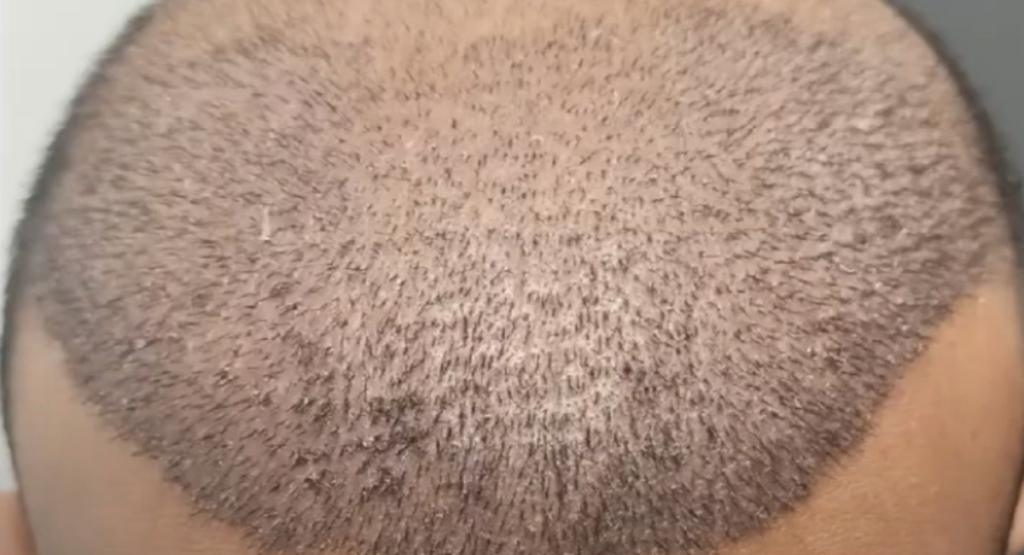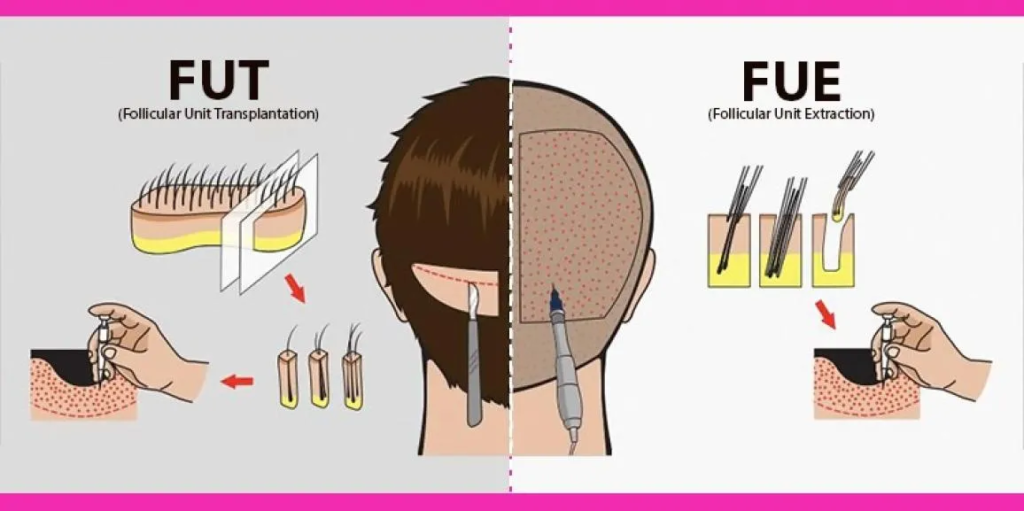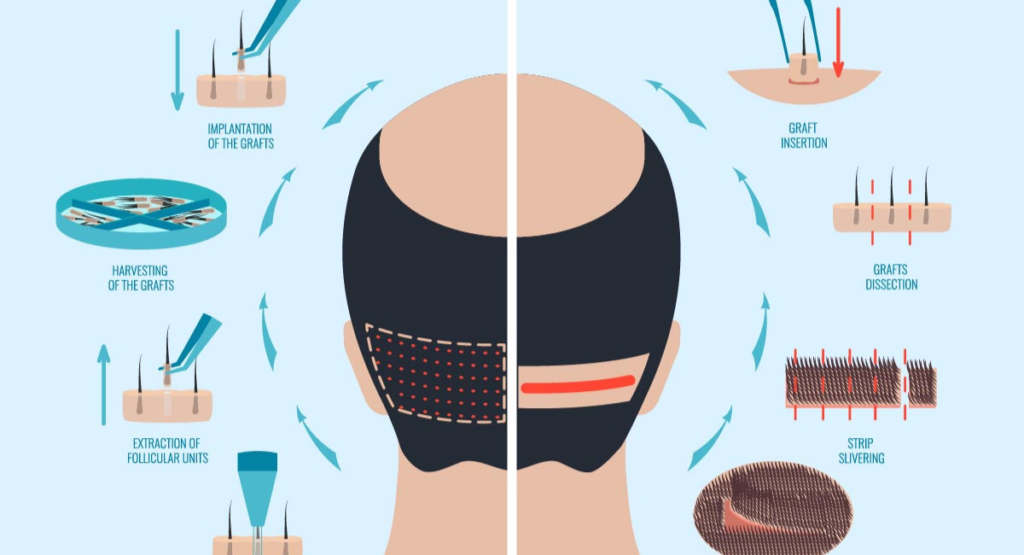- Make An Appointment
- +91-9460006594
- +91-9571548977
- info@jodhpurskintreatment.com
FUT vs FUE: Understanding Hair Transplant Techniques, Meaning, and Key Differences

Uneven Hairline in Men: Genetic Trait or Hair Loss Sign?
January 30, 2025
Laser Hair Removal for Women: Lasting Benefits & Results
March 29, 2025Hair loss affects millions of individuals worldwide, and hair transplantation has emerged as a reliable solution to restore hair growth. Among the different techniques available, FUT vs FUE hair transplants are the most commonly discussed options. Both methods provide natural-looking results but differ in their approach, benefits, and suitability for individuals.
What is FUE Hair Transplant?
FUE hair transplant, also known as Follicular Unit Extraction, is a modern hair restoration technique where individual hair follicles are extracted from the donor area and transplanted to the recipient site.

FUE Meaning and Procedure
The FUE technique involves using a micro-punch tool to extract hair follicles one by one from the scalp. These follicles are then implanted into the thinning or balding areas. The entire procedure is minimally invasive, resulting in faster recovery and less scarring compared to other methods.
Benefits of FUE Hair Transplant
- Minimally invasive: No stitches or linear scars.
- Faster healing: Recovery time is usually within a few days.
- Natural results: Hair grows in a natural pattern.
- Suitable for small procedures: Ideal for individuals who need a limited number of grafts.
What is FUT Hair Transplant?
FUT hair transplant, or Follicular Unit Transplantation, is a traditional technique that involves removing a strip of skin from the donor area, usually at the back of the head. The hair follicles from this strip are then extracted and transplanted.

FUT Procedure and Steps
In FUT hair transplant, a surgeon removes a strip of skin with healthy hair follicles, then dissects the strip under a microscope to obtain individual follicular units. These units are implanted in the balding area to promote new hair growth.
Advantages of FUT Hair Transplant
- High graft yield: Suitable for those requiring a large number of grafts.
- Cost-effective: Typically less expensive than FUE hair transplant.
- Better for advanced hair loss: Works well for individuals with extensive balding.
- Higher follicle survival rate: Less trauma to follicles during extraction.
FUT vs FUE: Key Differences
Both FUE and FUT hair transplant techniques aim to restore hair, but they have significant differences in procedure, recovery, and results.

Extraction Method
- FUE Hair Transplant: Extracts individual hair follicles.
- FUT Hair Transplant: Removes a strip of scalp containing follicles.
Scarring and Healing
- FUE Technique: Leaves tiny dot scars that are barely visible.
- FUT Hair Transplant: Leaves a linear scar but is hidden if hair is kept long.
Recovery Time
- FUE vs FUT: FUE allows faster recovery (a few days), while FUT takes longer (a couple of weeks).
Suitability
- FUE vs FUT: FUE hair transplant is ideal for smaller procedures and those who prefer short hair, while FUT hair transplant is recommended for individuals needing a high number of grafts.
FUE and FUT Hair Transplant: Which is Better?
When comparing FUE vs FUT, the best method depends on the individual’s needs. FUE hair transplant is best for those seeking a minimally invasive technique with minimal scarring, while FUT hair transplant is better suited for individuals requiring a large number of grafts.

Cost Considerations
- FUE Hair Transplant: Generally more expensive due to the time-consuming extraction process.
- FUT Hair Transplant: More affordable and cost-effective for those with extensive baldness.
Ideal Candidates for FUE vs FUT
FUE Hair Transplant is ideal for:
- Patients who prefer short hair.
- Those who want minimal scarring.
- Individuals needing small to medium grafts.
FUT Hair Transplant is best for:
- Those requiring large hair coverage.
- Patients with a high follicular unit requirement.
- Individuals who don’t mind a linear scar.
The Future of Hair Transplantation
As technology advances, both FUE and FUT hair transplant methods continue to improve. Surgeons now use robotic-assisted FUE hair transplant to increase precision and success rates. Similarly, FUT hair transplant techniques have evolved to minimize scarring and discomfort.Both FUE vs FUT methods offer effective solutions for hair restoration.

The choice between FUE and FUT hair transplant depends on the individual’s preferences, hair loss condition, and budget. Understanding FUE meaning, FUE technique, and the differences between FUT vs FUE will help individuals make informed decisions about their Hair Transplant in Jodhpur procedure.
FAQ
What is the difference between FUE and FUT hair transplant?
The main difference is in the extraction method. FUE hair transplant extracts individual follicles, while FUT hair transplant removes a strip of scalp to obtain follicles.
Which hair transplant method is better: FUT or FUE?
It depends on individual needs. FUE hair transplant is ideal for those wanting minimal scarring and a quick recovery, while FUT hair transplant is better for those requiring a large number of grafts.
Does FUE hair transplant leave scars?
Yes, but they are tiny dot scars that are barely visible, especially when hair grows out.
Is FUT hair transplant more painful than FUE?
FUT hair transplant may involve more discomfort due to the strip removal, whereas FUE hair transplant is less invasive and generally has a quicker recovery.
How long does it take to recover from FUE and FUT?
- FUE hair transplant: A few days to a week.
- FUT hair transplant: Two to three weeks.
Can I shave my head after a hair transplant?
Yes, but it is recommended to wait at least a few months to allow proper healing and graft stability.
How much does FUE vs FUT hair transplant cost?
FUE hair transplant is generally more expensive due to its meticulous extraction process, while FUT hair transplant is more affordable and better for extensive coverage.

